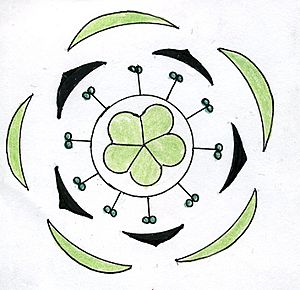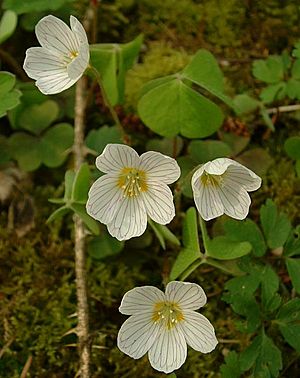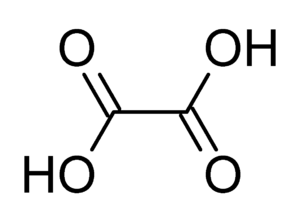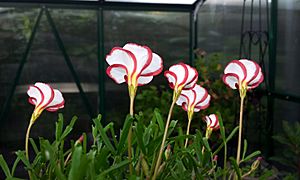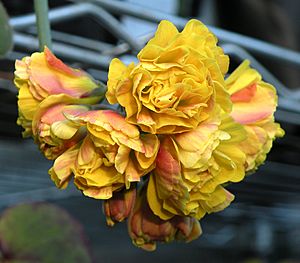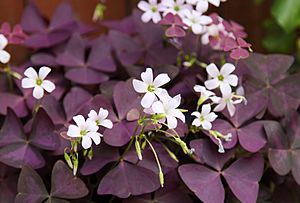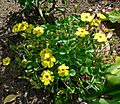Oxalis facts for kids
Quick facts for kids Oxalis |
|
|---|---|
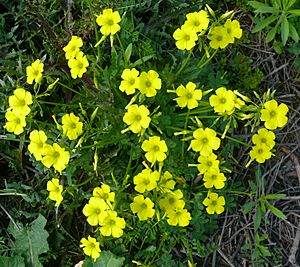 |
|
| Oxalis pes-caprae | |
| Scientific classification |
|
| Kingdom: | Plantae |
| Clade: | Tracheophytes |
| Clade: | Angiosperms |
| Clade: | Eudicots |
| Clade: | Rosids |
| Order: | Oxalidales |
| Family: | Oxalidaceae |
| Genus: | Oxalis L. |
| Species | |
|
About 550, see List of Oxalis species |
|
Oxalis is a big group of flowering plants, with over 550 different kinds! They are part of the wood-sorrel family, called Oxalidaceae. You can find Oxalis plants almost everywhere in the world, except for the very cold polar areas. Many types grow especially well in warm places like Brazil, Mexico, and South Africa.
Many of these plants are known as wood sorrels. They have a sour taste, a bit like lemons, which reminds people of another plant called sorrel. Some Oxalis plants are called yellow sorrels or pink sorrels because of their flower colors. Others are sometimes called false shamrocks or sourgrasses.
Contents
What are Oxalis Plants Like?
Leaves, Flowers, and Roots
Oxalis plants can be annuals (meaning they live for one year) or perennials (meaning they live for many years). Their leaves are usually divided into three to ten or more smaller parts. These parts are often shaped like a heart or a teardrop. Most Oxalis plants have three leaf parts, which makes them look a bit like clovers. Some species can quickly change the angle of their leaves. This helps them avoid too much sunlight and stay healthy.
The flowers of Oxalis plants have five petals, which are usually joined at the bottom. They also have ten stamens, which are the parts that make pollen. The petals can be white, pink, red, or yellow. The fruit is a small capsule that holds several seeds. Many Oxalis plants have thick, juicy roots that store energy. Some can also grow new plants from small parts called bulbils that break off.
Where Oxalis Plants Grow
Several types of Oxalis plants are very common in certain forest areas. For example, in the North American Pacific Northwest and parts of Australia, you might find lots of them. In Europe, the common wood sorrel (O. acetosella) often covers large areas in forests.
Some Oxalis species, like Bermuda-buttercup and creeping woodsorrel, can become invasive weeds. This happens when they escape from gardens and grow out of control in new places. It's hard to get rid of them because their roots can store a lot of energy, making them tough against weed control.
A study in 2019 suggested that Oxalis plants work together with tiny bacteria called Bacillus. These bacteria help the plants get nitrogen from the soil. This might be why Oxalis can spread quickly, even in poor soil.
Oxalis and Animals
Some small plant-eating animals, like the Montezuma quail, eat the roots of Oxalis plants. The leaves are also a food source for certain butterflies, such as the Polyommatini pale grass blue and dark grass blue.
Oxalis plants can sometimes get a plant disease called rust, which is caused by a fungus called Puccinia oxalidis.
How Humans Use Oxalis
Oxalis as Food
Wood sorrel, a type of Oxalis, is a wild plant that people have eaten for thousands of years. Native American groups used it in many ways:
- The Kiowa people chewed wood sorrel to help with thirst on long journeys.
- The Potawatomi cooked it with sugar to make a dessert.
- The Cherokee ate wood sorrel to help with mouth sores and sore throats.
- The Iroquois ate wood sorrel to help with cramps, fever, and nausea.
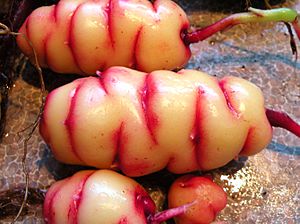
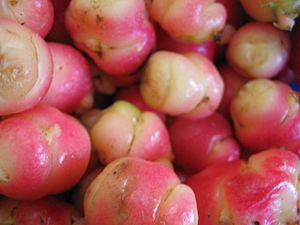
The juicy, edible roots of a type of Oxalis called oca (O. tuberosa) have been grown for food in Colombia and other parts of the Andes mountains in South America for a long time. In New Zealand, oca is sold as "New Zealand yam," even though it's not a true yam. You can find different colors of oca now, like yellow, orange, apricot, and pink.
Sailors traveling around Patagonia used to eat the leaves of scurvy-grass sorrel (O. enneaphylla). It was a good source of vitamin C, which helped them avoid a disease called scurvy.
In India, creeping wood sorrel (O. corniculata) is eaten only at certain times of the year. The Bodos in northeast India sometimes use its leaves to make a sour fish curry. You can also dry the leaves of common wood sorrel (O. acetosella) to make a lemony-tasting tea.
Oxalic Acid in Oxalis

One special thing about Oxalis plants is that they contain oxalic acid. This is what gives their leaves and flowers that sour taste. Oxalic acid is also found in many other common foods you might eat, like spinach, broccoli, brussels sprouts, grapefruit, and rhubarb.
Eating very large amounts of oxalic acid can be slightly harmful because it can affect your digestion and kidneys. However, for most people with healthy kidneys, eating Oxalis in normal amounts is usually not a problem. The U.S. National Institutes of Health says that since oxalic acid is in many foods, its effects are usually not a big concern for people who eat a variety of foods.
In the past, people would take out crystals of calcium oxalate from Oxalis plants. They used these crystals to treat diseases or as a "salt of lemon."
Oxalis as Garden Plants
Many types of Oxalis are grown as pot plants or ornamental plants in gardens because they are pretty. For example, O. versicolor is a popular choice.
Oxalis flowers come in many colors, including white, yellow, peach, pink, and even multi-colored. Some types have double flowers, like the double form of O. compressus. Other varieties are grown for their interesting leaves, such as O. triangularis, which has dark purple leaves.
Some Oxalis species, especially O. tetraphylla (four-leaved pink-sorrel), are sometimes sold as "four-leaf clovers." People buy them hoping for good luck, just like with real four-leaf clovers.
Selected Species
- Oxalis acetosella – common wood sorrel, stabwort
- Oxalis adenophylla – Chilean oxalis, silver shamrock
- Oxalis albicans – hairy woodsorrel, white oxalis, radishroot woodsorrel, radishroot yellow-sorrel, California yellow-sorrel
- Oxalis alpina – alpine sorrel
- Oxalis ambigua
- Oxalis articulata Savign. – pink-sorrel
- Oxalis ausensis
- Oxalis barrelieri – lavender sorrel
- Oxalis bowiei – Bowie's wood-sorrel, Cape shamrock
- Oxalis brasiliensis – Brazilian woodsorrel
- Oxalis caerulea – blue woodsorrel
- Oxalis caprina
- Oxalis corniculata – creeping wood sorrel, procumbent yellow-sorrel, sleeping beauty, chichoda bhaji (India)
- Oxalis debilis Kunth
- Oxalis decaphylla – ten-leaved pink-sorrel, tenleaf wood sorrel
- Oxalis dehradunensis
- Oxalis depressa
- Oxalis dichondrifolia – peonyleaf wood sorrel
- Oxalis dillenii Jacquin – southern yellow woodsorrel, Dillen's woodsorrel, Sussex yellow-sorrel
- Oxalis drummondii – Drummond's woodsorrel, chevron oxalis
- Oxalis ecuadorensis
- Oxalis enneaphylla – scurvy-grass sorrel
- Oxalis exilis – least yellow-sorrel
- Oxalis frutescens – shrubby wood-sorrel
- Oxalis gigantea
- Oxalis glabra – finger-leaf
- Oxalis grandis – great yellow-sorrel, large yellow woodsorrel
- Oxalis griffithii Edgew. & Hook.f.
- Oxalis hedysaroides – fire fern
- Oxalis hirta – hairy sorrel
- Oxalis illinoensis – Illinois wood-sorrel
- Oxalis inaequalis
- Oxalis incarnata L. – pale pink-sorrel
- Oxalis lasiandra – Mexican shamrock
- Oxalis latifolia Kunth – garden pink-sorrel
- Oxalis luederitzii
- Oxalis luteola Jacq.
- Oxalis magellanica G.Forst.
- Oxalis magnifica Kunth – snowdrop wood-sorrel
- Oxalis massoniana
- Oxalis megalorrhiza – fleshy yellow-sorrel
- Oxalis melanosticta
- Oxalis micrantha – dwarf woodsorrel
- Oxalis montana – mountain woodsorrel, white woodsorrel
- Oxalis nelsonii – Nelson's sorrel
- Oxalis norlindiana
- Oxalis obliquifolia
- Oxalis oregana – redwood sorrel, Oregon sorrel
- Oxalis ortgiesii Regel – fishtail oxalis
- Oxalis pennelliana
- Oxalis pes-caprae – Bermuda-buttercup, African wood-sorrel, Bermuda sorrel, buttercup oxalis, Cape sorrel, English weed, soursob, "goat's-foot", "sourgrass", soursop (not to be confused with the fruit of that name)
- Oxalis priceae – tufted yellow-sorrel
- Oxalis pulchella
- Oxalis purpurea L. – purple wood-sorrel
- Oxalis rosea Feuillée ex Jacq. – annual pink-sorrel
- Oxalis rubra A.St.-Hil. – red wood-sorrel
- Oxalis rufescens
- Oxalis rugeliana – coamo
- Oxalis schaeferi
- Oxalis spiralis – spiral sorrel, volcanic sorrel, velvet oxalis
- Oxalis stricta – common yellow woodsorrel, common yellow oxalis, upright yellow-sorrel, lemon clover, "pickle plant", "sourgrass, "yellow woodsorrel"
- Oxalis suksdorfii – western yellow woodsorrel, western yellow oxalis
- Oxalis tenuifolia – thinleaf sorrel
- Oxalis tetraphylla – four-leaved pink-sorrel, four-leaf sorrel, Iron Cross oxalis, "lucky clover"
- Oxalis triangularis – threeleaf purple shamrock
- Oxalis trilliifolia – great oxalis, threeleaf woodsorrel
- Oxalis tuberosa – oca, oka, New Zealand yam
- Oxalis valdiviensis – Chilean yellow-sorrel
- Oxalis virginea – virgin wood-sorrel
- Oxalis versicolor – candycane sorrel
- Oxalis violacea – violet wood-sorrel
- Oxalis vulcanicola – volcanic sorrel or velvet oxalis
Gallery
-
Oxalis gigantea Barneoud, 1846
See also
 In Spanish: Oxalis para niños
In Spanish: Oxalis para niños


